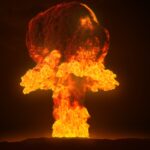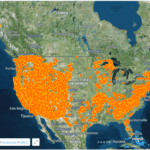
Nuclear attack is an unnerving thought. Fallout can quickly cause suffocation, burns and cardiac arrest while over time it could lead to cancers and other health issues.
Recent international political developments and threats from world leaders has caused more people to look for “fallout shelters near me”. But where should they go?
Public Shelters
Public shelters may be your best bet in an event of nuclear catastrophe. These underground spaces were created specifically to shield people from radioactive fallout and debris, and may come equipped with food and water supplies as well. They may be found anywhere from parking garages, subway stations and basements – often marked by three upside-down triangles enclosed within a circle – though usually underground parking garages, subway stations or basements will do. Insulated shelters will offer greater protection; their protective factor (PF) numbers indicate how much radiation you will absorb.
Nuclear bombs create a fireball which blasts miles into the sky, collecting dirt and other debris along its path – including radioactive fallout, which could contaminate everything it touches – including you and your loved ones. Therefore, it is vital that you know where your nearest fallout shelter is located should the worst happen – being caught unaware by an attack could leave little time to find suitable refuge.
Survival during a nuclear catastrophe begins by getting inside as soon as possible, particularly within 10-15 minutes after an explosion has taken place. Shelter is always preferred, however any brick or concrete building may provide some shelter from shockwaves and heat generated from nuclear blasts.
Once you reach your shelter, remain there as long as possible to give the radiation-charged particles time to dissipate before you can safely leave. Make sure there’s enough food and water available during this period for yourself and any family members in your care.
At its height in the Cold War era, New York had thousands of fallout shelters to protect residents from nuclear destruction. Most were made of concrete windowless rooms filled with canned foods and supplies for survival for several days – these shelters were surveyed and certified by civil defense agents, who issued placards as certificates. Some remain today as storage or other uses.
Private Shelters
With Russia and Ukraine’s nuclear posturing resurfacing recently, questions regarding survival from a nuclear attack have once again come into the limelight. While such disaster is unlikely, being aware of public and private fallout shelters near you is essential.
Nuclear bombs create a fireball-like explosion that vaporizes everything in its path and spreads radioactive particles throughout the surrounding area, potentially poisoning it with deadly radiation that can lead to acute and chronic health conditions. Anyone who survives such an event must quickly find and enter an evacuation shelter so as to avoid lethally poisoning themselves.
After a nuclear detonation, you may only have 10-15 minutes to find refuge from radioactivity. Without designated sheltering arrangements in place, your best choice should be to seek refuge inside a thick-walled building with few windows (ideally multistory buildings or basements but even roofs of houses can provide some shelter) with thick walls that lack windows – the higher its Protective Factor rating will offer more protection.
Some buildings with high protection factors (PFs) include supermarkets, fire department and police stations, casinos and fire stations – these buildings tend to be easily accessible and will likely have food and water stocks readily available for consumption. It is wise to be prepared for sharing space with survivors who might also be covered in radioactive ash; otherwise mob mentality could arise quickly; staying together and giving newcomers enough time to evacuate are key priorities during such times of unrest.
Many locations possess tunnels, caves and catacombs that would serve as perfect places to hide in case of nuclear catastrophe. You can quickly discover many such spots by performing an online search for “urban exploring underground [city name].” Search results reveal hidden subway concourses in Philadelphia; catacombs under San Francisco; tunnels in cemeteries as well as tunnels deeper within subway systems away from entrances where newcomers might carry nuclear fallout on their skin; or you could increase protection by going deeper within each system and moving deeper underground, leaving newcomers carrying nuclear fallout on their skin at bay – options not present at its entrances!
Home is usually the safest shelter available to us; however, this may not always be practical for everyone. When designing your new house it can be wise to incorporate a bunker or similar solution into its design; free plans allow you to construct comfortable bunkers at minimal costs for you and your family. Alternatively existing structures could also be modified in this manner; such as repurposing septic tanks and large culverts as a possible source.
Caves
As the conflict in Ukraine escalates and Russia continues its threats of nuclear attack against the US, people have increasingly turned their focus toward finding nuclear fallout shelter near them. Without designated fallout shelters available to them in their city, chances of survival would be very limited in an attack scenario; thankfully there are a few public shelters scattered throughout the US which you can locate online maps; but bear in mind these maps may no longer contain accurate data as many shelters no longer exist or may no longer serve their original purpose.
Ideal fallout shelters should be made of concrete, as this will protect you both from initial nuclear blast and radioactive fallout that might follow it. Unfortunately, this is often impossible due to no buildings or structures offering enough shelter from nuclear explosion. If unable to locate such an underground refuge, simply try remaining as far from it as possible by lying down on the ground as soon as the explosion begins.
As another option for fallout shelter, caves offer more protection than houses or other buildings because they’re dug into the earth and feature layers of dirt covering it. However, before choosing this shelter type as your fallout refuge you must ensure that it can fit all members of your household comfortably as well as be well insulated against cold and heat loss.
If you have the resources, building a bunker in your backyard may be a viable option. Though more costly than public shelters, bunkers offer greater proximity and more privacy while providing safe shelter from nuclear fallout and the dangers associated with radiation and chemicals. When searching for such bunkers near home and underground is best.
Bunkers
As recent international political developments and renewed nuclear threats spark interest in fallout shelters near me, searches have spiked. Although most will survive nuclear blasts without direct exposure, their radiation may cause suffocation, skin burns and cardiac arrest in immediate cases while over time leading to cancers and more serious medical concerns.
Finding public shelter is your best defense from radiation exposure during a nuclear catastrophe. These structures typically consist of large, sturdy buildings like schools or research facilities designed to house up to 50 people during a nuclear attack, usually marked with the universal fallout shelter sign: three upside triangles enclosed within a circle. In cities, such structures are easily identified by location and color: red shelters indicate official government-owned facilities while blue ones indicate private ones.
Some homes include basements that can function as fallout shelters, though these spaces may not always provide optimal results. If you’re planning on moving into a new home, try to incorporate an area for nuclear bunker protection into the design from day one – this will ensure maximum safety in this space and will also make adding ventilation systems simpler.
As well as finding a safe place, it is also essential that you secure supplies of fresh water and non-perishable food, and have access to radio or phone communication to stay in contact with outside world and keep abreast of news updates. When possible, stay away from windows and doors of shelter to prevent fallout entering and polluting interior areas of shelter.
If you can’t afford to build your own bunker, pre-made ones may offer better protection than your typical basement or root cellar. They usually include kitchens, bathrooms and showers – as well as ventilation systems which can be managed manually or remotely in case of disaster.




